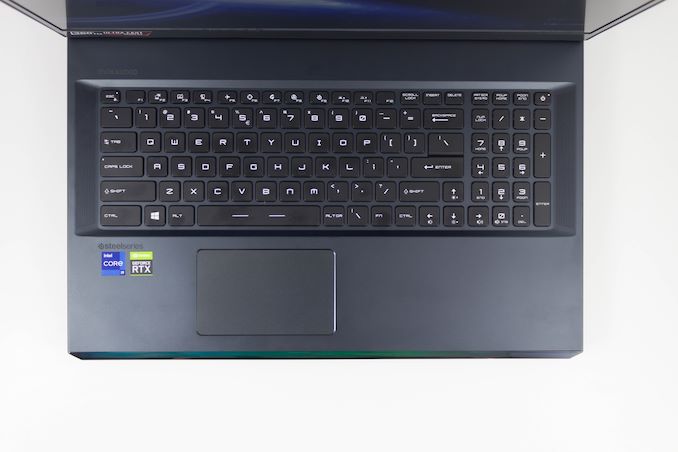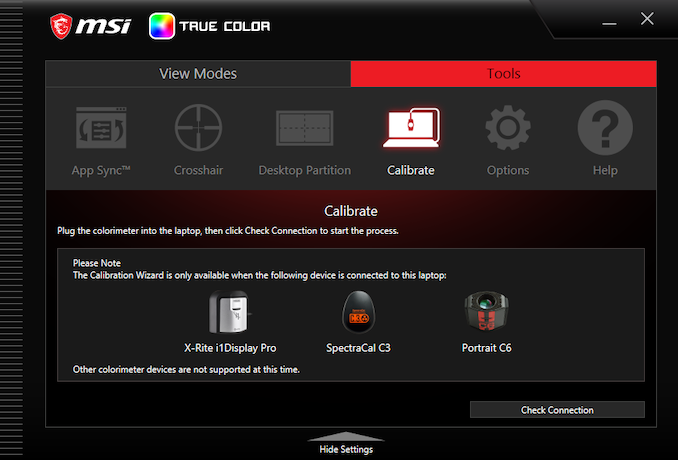Intel Alder Lake-H Core i9-12900HK Review: MSI's Raider GE76 Goes Hybrid
by Brett Howse on January 25, 2022 9:00 AM EST- Posted in
- CPUs
- Intel
- MSI
- Laptops
- Alder Lake
- GE76 Raider
- 12th Gen Core
- Alder Lake-H
The Test Platform: MSI's Raider GE76
For 2022, MSI has not updated the underlying chassis for the new Alder Lake product, and as such our review of the GE76 Raider from 2021 with Tiger Lake does not fundamentally change in terms of chassis design and cooling. This is still a big, relatively heavy desktop-replacement system. It features an aluminum surface where you will be touching it, and a polycarbonate base.
MSI generally builds a very solid product, and for 2022 they have upgraded the cooling with a new phase-change thermal pad which allows them to wick heat away from the processor and GPU quicker, without some of the negatives of a pure-liquid thermal compound and crystallization that can occur.
The system offers a per-key RGB backlit keyboard from SteelSeries. There is a 1080p webcam as well, and the system now offers an AI-based setting to let the system automatically switch the power levels for the user without having to manually do it, although the manual options are still there. MSI has updated their Silent mode to now leverage the microphones on the system to match the noise floor of the room, which lets them extract more power from the processor, and more fan speed, while still being inaudible.
The Raider GE76 offers lots of connectivity, including a single Thunderbolt 4 port, an additional USB Type-C port, and several USB Type-A ports. There is also a SD card reader which is still convenient when uploading from a camera.
The system offers Wi-Fi 6E support thanks to the Killer AX1675 Wi-Fi adapter, and also includes the Killer E3100G 2.5 Gbps Ethernet adapter.
MSI offers a range of display options, with a 1920x1080 144 Hz panel on their least expensive Raider GE76, a 1920x1080 360 Hz panel which is in the sampled unit, a 2560x1440 240 Hz panel, and a 3840x2160 120 Hz offering.
On our Tiger Lake sample we reviewed late last year, the display accuracy was not up to par with typical MSI offerings. Thankfully that appears to have been a one-off, which we do see from time to time even on devices that are hardware calibrated at the factory. MSI does allow you to use a built-in tool to calibrate the display, but you do need a supported colorimeter.
Thanks to Portrait Displays for the use of their Calman software so we can continue to accurately measure displays for our reviews.
As you can see, the color accuracy of this sample is much improved over the Tiger Lake model from last year that we received.
Brightness and Contrast



Grayscale

Gamut

Saturation

Gretag Macbeth

The MSI Raider GE76 is a fantastic test bed for Intel's Alder Lake system, with a powerful cooling system, and a great build quality.




















153 Comments
View All Comments
soloracerx - Tuesday, January 25, 2022 - link
NewEgg just put up the pre-orders today for the MSI line 12th gen lappys. Staggered release from Feb through April. The one reviewed here will be available 3/28/22 for $4199. https://www.newegg.com/p/pl?d=12th+gen+laptopmabellon - Tuesday, January 25, 2022 - link
“The new Alder Lake system could only average 83% of its original frames per second, because that task was deprioritized by Thread Director to free up additional resources for the foreground jobs.”Foreground and background detection is provided by the OS. The CPU alone has no way to identify which threads are rendering on screen, the OS and window management tracking is responsible. This window tracking, and more, are critical for hybrid scheduling, favored core scheduling, etc. Https://docs.microsoft.com/en-us/windows/win32/procthread/quality-of-service
If you want to test Thread Director you need to test workloads with multiple concurrent workload classifications by Thread Director. A complex workload (or multiple concurrent workloads) with different thread execution (I.e. some AVX, some not). For example, if you have two on-screen workloads (I.e. both prefer performance), but there are more concurrent workload threads to schedule than there are P-Cores, which subset of those threads will get the most performance out of the limited set of P-Cores?Homogenous workloads where all threads are roughly equivalent and running the same instruction mix are unlikely to have much impact (e.g. Cinebench, Handbrake). Workloads that fit entirely on P-Cores are unlikely to have much impact as there is no overflow to E-cores.
Another alternative would be if a particular workload classification was inverted versus the norm. For example, normally one would expect E-cores to be the most efficient. On a laptop you might want background services and apps scheduled to the most efficient cores for battery life. But what if the workload running happens to heavily exercise instructions that are actually more efficient to run on P-cores?
Those are some examples of how Thread Director plays a role.
kenansadhu - Thursday, January 27, 2022 - link
Will it be where the AMD's design win out? Because there wouldn't be any risk for the user of any OS or scheduler's mistake (since all cores are the same).Da W - Tuesday, January 25, 2022 - link
I remember back in the days when AMD GPU was beating NVIdia but with 50 watt more power draw, they were discarded as crap!How things change. Wattage does not seem to matter anymore.
Calin - Wednesday, January 26, 2022 - link
I chose nVidia because I didn't had a PCI-E power cable (or the wattage). At roughly similar price and performance, AMD broke the 75W limit and nVidia didn't.With processors already installed in systems, the equation changes a bit - you can still get the performance, at a lower battery life.
Spunjji - Thursday, January 27, 2022 - link
Generally speaking, you can assume that watts are important when AMD draw more of them; not so much when Intel or Nvidia draw more and win.TheinsanegamerN - Friday, January 28, 2022 - link
Nobody disregarded AMD's hawaii GPUs for pulling more power, tech media was singing their praises from every rooftop.They slammed the 390x for being just a rebranded 290x that drew even more power but couldnt keep up with nvidia's high end.
But context is the enemy of the fanboi.
BillBear - Tuesday, January 25, 2022 - link
You guys really need to start posting performance numbers when the laptop is unplugged, now that power draw figures have become so ridiculous that laptops immediately have to throttle down when unplugged.TekCheck - Tuesday, January 25, 2022 - link
Benchamark tech-tubers and tech website should follow Anandtech's practice and start publishing performance+power benchmarks for laptops, to give us better context behind high bars in any test. This is less important for desktops, but as laptops are usually portable devices, it is paramount that we know the power behind performance.If 12900HK is winning in any bars, say 20% over 6900HX, we need to know at which power level. Is it at 45W? At 60W? At 115W? If the win is at high wattage only, users will have a wrong impression that such CPU has "better" performance, which is untrue without knowing the power needed for such performance.
Brett Howse - Tuesday, January 25, 2022 - link
Mentioned this in the review. The AMD 5900HX system also draws the same power at load.